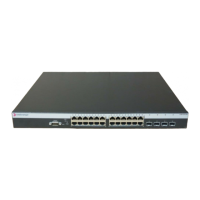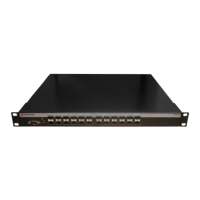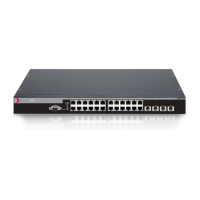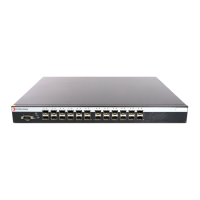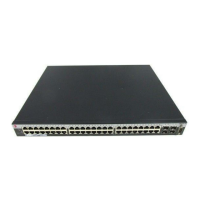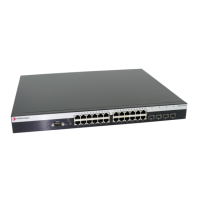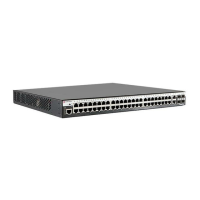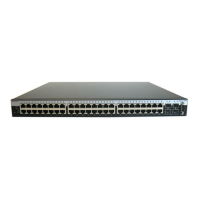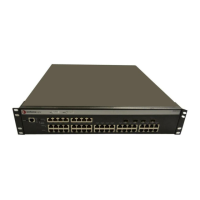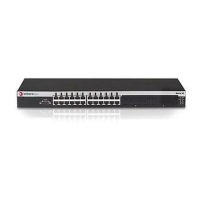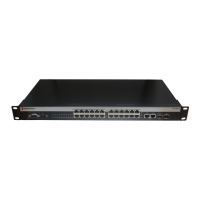
Do you have a question about the Enterasys C5G124-24 and is the answer not in the manual?
| Model | C5G124-24 |
|---|---|
| Ports | 24 x 10/100/1000Base-T |
| Switching Capacity | 48 Gbps |
| Forwarding Rate | 35.7 Mpps |
| Power over Ethernet (PoE) | No |
| MAC Address Table Size | 16K |
| Jumbo Frame Support | Yes |
| Uplink Ports | 4 x Gigabit Ethernet SFP |
| Layer | Layer 2/3 |
| VLANs Supported | 4, 096 |
| Power Supply | Internal |
| Form Factor | Rack-mountable |
Step-by-step guide to connect a PC to the switch console port and set the initial IP address.
Procedure for downloading and installing new firmware images onto the switch using TFTP.
Guides on creating, managing, and disabling user accounts and passwords for enhanced security.
Procedure for setting up multiple new stackable switches in a stack configuration.
Procedure to download switch firmware via the serial console port using XMODEM transfer.
Procedure for installing a new stack of up to eight units, including physical connections and CLI setup.
Procedure for integrating a new unit into an existing stack configuration.
Describes how to start a CLI session, log in, and navigate the CLI.
Steps for connecting to the switch via the console port and logging in.
Instructions for establishing a Telnet or SSH session to the switch's IP address.
Details on logging in using default user accounts or administratively configured accounts.
How to configure CLI properties like command prompt, banner messages, and session timeout.
Lists factory default settings for basic switch and router operations.
Overview of configuring system services, switching, routing, and security features.
Information on enabling advanced features using license keys and implementation differences.
Describes SNTP for synchronizing system time, supporting unicast polling and broadcast listening.
Explains SNTP security mechanisms to ensure responses come from authorized servers.
Procedures for configuring general SNTP parameters and authentication.
Explains DHCP for IPv4, implementing automatic or manual IP address assignment via servers.
Details DHCP server functionality for providing basic IP configuration information to clients.
Configuration requirements for automatic (dynamic) and manual (static) IP address pools.
Ways to configure a DHCP server by associating pools with host port or routed interfaces.
Procedures for basic configuration of automatic and manual IP address pools.
Steps to enable or disable Telnet services, inbound, outbound, or all.
Steps to enable, disable, or reinitialize the SSH server on the switch.
Configuration options for aging learned MAC addresses and limiting multicast addresses.
Describes user account and password management features for controlling usage and reporting.
Configures account lockout based on failed login attempts or periods of inactivity.
Shows how a super-user creates new user accounts and sets passwords.
Details password configuration, transmission, storage, and validation.
How to configure system-wide password requirements like length, repetition, and aging.
Procedure for configuring system-level password settings using CLI commands.
How to download, set firmware for startup, revert to previous image, and set TFTP parameters.
Describes two methods to download firmware: TFTP/SFTP or serial port.
Procedure for downloading firmware using TFTP or SFTP server connected to the network.
How to set the firmware image to be loaded at startup and reboot the system.
Steps to downgrade to a previous version of code, including backing up configuration.
Covers configuration persistence modes and managing files on the switch.
Use 'save config' to save running configuration and 'show config' to display.
Describes redundant and additive power supply modes supported on C5 and G-Series switches.
Explains PoE standards (802.3af, 802.3at) and its ability to provide power via Ethernet.
Steps to configure PoE on compliant devices, ensuring PD power requirements are met.
Lists PoE settings configurable via CLI across different Enterasys device models.
Describes basic port parameters, link flap detection, port mirroring, and queue monitoring.
Describes port settings that can be configured, including status, name, and auto-negotiation.
Monitors link flapping to detect physical layer problems, disabling ports and generating notifications.
Monitors transmit queues for stalled ports and takes corrective action.
Allows mirroring or redirecting traffic on a port for network analysis and connection assurance.
Use 'set port mirroring' to create, enable, or disable mirroring relationships.
Defines VLANs as logical segments for network devices, regardless of physical location.
How Virtual LANs partition network traffic into logical groups for control and isolation.
Explains default 802.1Q VLAN operational mode and how to create additional VLANs.
Explains how 802.1Q VLAN operation works, including frame classification and forwarding.
How frames are classified into VLANs and how forwarding decisions are made.
Presents procedures for configuring VLANs after planning implementation strategy.
Describes how to create and configure a static VLAN, using unspecified parameters default values.
Describes how to enable GARP VLAN Registration Protocol (GVRP) for dynamic VLAN creation.
How to define protocol-based frame filtering policies to assign frames to particular VLANs.
Describes user authentication methods supported by Enterasys fixed switch platforms.
Steps to implement user authentication: determine device types, authentication types, and configure RADIUS.
Details supported authentication methods: IEEE 802.1x, MAC-Based, Port Web, and Multi-User/MultiAuth.
Explains IEEE 802.1x port-based access control using EAP for authentication via RADIUS.
Authenticates devices using source MAC address, providing basic device authentication.
Authenticates users via web browser login, supporting CHAP or PAP verification.
Discusses multi-user authentication (multiple devices on one port) and MultiAuth (multiple methods).
Supports multiple authentication methods per user/port, applying based on precedence.
Provides details for configuring RADIUS and RFC 3580 attributes for authentication and authorization.
How RADIUS tunnel attributes are used for dynamic VLAN assignment of authenticated end systems.
Provides details for configuration of authentication methods, MultiAuth and RADIUS.
Steps to configure IEEE 802.1x on an authenticator switch port.
Steps to configure MAC-based authentication on a switch.
Steps to configure PWA authentication, including IP address, enhanced mode, and port control.
Details configuration of MultiAuth authentication mode, precedence, port properties, and timers.
Determines which authentication method is selected when multiple methods authenticate successfully.
Allows dynamic assignment of users to VLANs via RADIUS, enabling VLAN authorization globally and per-port.
Details setting, clearing, and displaying RADIUS configuration for authentication and accounting.
Covers authentication types used in an engineering group scenario.
Sets MultiAuth mode, port modes, and user limits for authentication.
Describes IEEE 802.3ad link aggregation, grouping interfaces into logical Layer 2 links.
Steps to implement link aggregation: enabling LACP, setting priority, keys, and port states.
Provides details for link aggregation configuration on N-Series, S-Series, stackable, and standalone switches.
Example configuration including a fixed switch stack, distribution switch, and server.
Basic SNMP concepts, support on Enterasys switches, and configuration using CLI commands.
Describes the process of implementing SNMP, involving users, groups, access rights, and target parameters.
Provides information on configuring SNMP on Enterasys devices using CLI commands.
Steps to configure SNMP: define users, groups, access rights, target parameters, and notification entries.
Procedure and examples for creating new SNMPv1 or SNMPv2c configurations.
Shows how to complete a basic SNMPv3 configuration.
Recommended configuration to prevent unsecured SNMPv1/v2c access.
Describes Layer 2 process of identifying and advertising devices to connected neighbors.
How network devices advertise identities and capabilities using LLDP, Enterasys, and Cisco Discovery Protocols.
Provides LLDP configuration commands and procedures.
Provides Enterasys Discovery Protocol configuration commands.
Describes how Cisco DP extended trust settings work on the switch.
Describes Syslog protocol for forwarding log messages in IP networks for system management.
How Syslog components operate on Enterasys switches, generating and forwarding messages.
Describes key Syslog components like Facility, Severity, Application, and Syslog server.
Provides a mechanism for generating a secure log file for security-related events.
Provides procedures for configuring logging tasks.
Commands to configure one or more servers as destinations for Syslog messages.
Explains STP's role in resolving network loops by establishing one primary path.
Details STP, RSTP, and MSTP protocols and their operation in forming a network of bridges.
Provides traffic forwarding on multiple ports, allowing VLAN segregation and link utilization.
Protects against DoS conditions by detecting unauthorized bridges and preventing respans.
Prevents or short-circuits loop formation by requiring ports to receive BPDUs.
Provides detailed understanding of Spanning Tree operations in a typical network.
Enables multiple Spanning Trees for VLAN switching, increasing bandwidth utilization.
Provides configuration procedures for Spanning Tree Protocol and Rapid Spanning Tree Protocol.
Details MSTP requirements for multiple forwarding paths, matching configuration identifiers.
Explains SpanGuard's role in detecting unauthorized bridges and preventing DoS conditions.
Commands to configure device ports for SpanGuard and enable the SpanGuard function.
Explains Loop Protect's function in preventing network loops by requiring BPDUs.
Provides information on enabling/disabling Loop Protect and specifying partners.
Policy as a component of Secure Networks for role-based profiles and resource provisioning.
Overview of policy implementation, role definition, classification rules, and application.
How to create policy roles using 'set policy profile' command.
Explains admin rules and traffic classification rules for policy enforcement.
How to apply policy profiles and rules to ports (default policy) or dynamically via authentication.
Presents configuration procedures and command descriptions for policy profiles and traffic classification rules.
Explains QoS as a mechanism for bandwidth management and preferential packet treatment.
Steps to determine flow characteristics and configure appropriate link behavior.
Manages bandwidth aligning delivery requirements with port resources using packet classification.
Implements QoS features using hardware resources like Inbound Rate Limiters and Flood Control.
Describes three types of preferential queue treatments: strict priority, weighted fair, and hybrid.
Controls traffic rate entering a switch per CoS to throttle flows and provide bandwidth for others.
Assigns mission-critical data to higher priority queues during congestion.
Limits inbound traffic rate on a per port/priority basis to throttle flows.
Covers history buffer, network diagnostics, switch connection statistics, and users.
Provides ping and traceroute functionality to determine network availability and paths.
Remote Network Monitoring provides network fault diagnosis, planning, and performance tuning.
Provides details for configuring RMON on Fixed Switch products.
Method for monitoring high-speed switched and routed networks using sampling technology.
Provides overview and steps to configure sFlow, including collectors and management interface.
Explains multicast as a one-source to many-destinations method for sending information.
Steps to implement multicast protocols (IGMP, DVMRP, PIM-SM) using CLI commands.
How multicast uses network infrastructure efficiently by sending one copy of traffic.
Fundamental protocol for managing group membership in IP multicast.
Interior gateway protocol for routing multicasts within a single autonomous system.
Dynamically builds a distribution tree for forwarding multicast data.
Describes IGMP configuration on Layer 2 for snooping and Layer 3 for host membership.
DVMRP is an advanced routing feature requiring a license key.
PIM-SM is an advanced routing feature requiring a license key.
Enables IP configuration and router-specific commands after startup and general settings.
Creates routing interfaces using the 'interface' command in router global configuration mode.
Configures primary and optionally secondary IPv4 addresses for routing interfaces.
Configures static routes using 'ip route' command, specifying destination and next-hop IP.
Uses 'ping' and 'traceroute' commands to test routing network connectivity.
Manages directed broadcasts and UDP broadcast forwarding.
Describes RIP, a distance-vector routing protocol for small networks.
Enables RIP process, populating routing table and sending/receiving updates.
Enables RIP on individual routing interfaces and configures optional parameters.
ICMP Router Discovery Protocol (IRDP) enables hosts to determine router addresses.
Open Shortest Path First (OSPF) is a TCP/IP routing protocol distributing link state information.
Overview of basic OSPF topology, areas, router types, designated router, and authentication.
Assigns a router ID based on loopback or VLAN IP address for unique identification.
Groups contiguous networks into areas, hiding topology from the rest of the AS.
Configures an area as stub, preventing external routes and using a default route.
Configures a hybrid area allowing injection of external routes into NSSA.
Enables OSPF on routing interfaces and configures IP address, area ID, and priority.
Ensures routing information is processed only from trusted routers using simple or MD5 schemes.
Describes OSPF interface configuration tasks executed in router interface configuration mode.
Describes OSPF area configuration tasks executed in router configuration mode.
Describes Virtual Router Redundancy Protocol (VRRP) feature and its configuration.
Provides details for VRRP configuration on fixed switch products.
Shows a basic VRRP configuration with a single virtual router.
ACLs allow configuration of permit/deny for IPv4, IPv6, and MAC packet forwarding.
Steps to implement an ACL: create ACL, enter rules, and optionally manage ACL entries.
Describes ACL creation, rule entry, and application to ports or routing VLANs.
Details standard (numbered 1-99) and extended (numbered 100-199) IPv4 ACL types.
Configures IPv6 or MAC ACLs after enabling 'ipv6mode'.
Procedures for deleting, moving, replacing, inserting, and applying ACLs.
Applies ACLs to VLAN interfaces, ports, or Link Aggregation ports.
Provides procedures and examples for configuring IPv4, IPv6, and MAC ACLs.
Describes how to configure IPv4 standard and extended ACLs.
Describes how to configure an IPv6 ACL.
Describes how to configure a MAC ACL.
Enabling/disabling IPv6 management, configuring addresses, and monitoring network connectivity.
Requires IPv6 routing to be enabled with a license key.
Describes coexistence of IPv6 and IPv4, and enabling IPv6 routing on VLAN interfaces.
Configures global unicast and link-local IPv6 addresses on interfaces.
Configures IPv6 static routes in router global configuration mode.
Determines how the switch performs cryptographic functions.
Explains Normal and FIPS 140-2 modes and their impact on cryptographic functions.
Lists commands to configure the security mode of the switch.
Provides functionality of current IPsec implementation on Fixed Switches.
Lists commands to configure IPsec parameters and enable/disable IPsec on RADIUS servers.
Explains MS-CHAPv2 management authentication and supported RADIUS attributes.
Locks MAC addresses to ports, preventing unauthorized device connections.
Lists commands to configure MAC locking on the Fixed Switch platforms.
TACACS+ is a security protocol alternative to RADIUS for authentication, authorization, accounting.
Steps to configure TACACS+ servers, including IP address, port, secret, and authorization.
Provides security for switch management features by allowing only known trusted devices access.
Configures a service access control list with unique priority rules.
Monitors DHCP messages to filter harmful messages and build a bindings database.
Rejects invalid and malicious ARP packets to prevent man-in-the-middle attacks.
Lists commands used to configure DAI.
